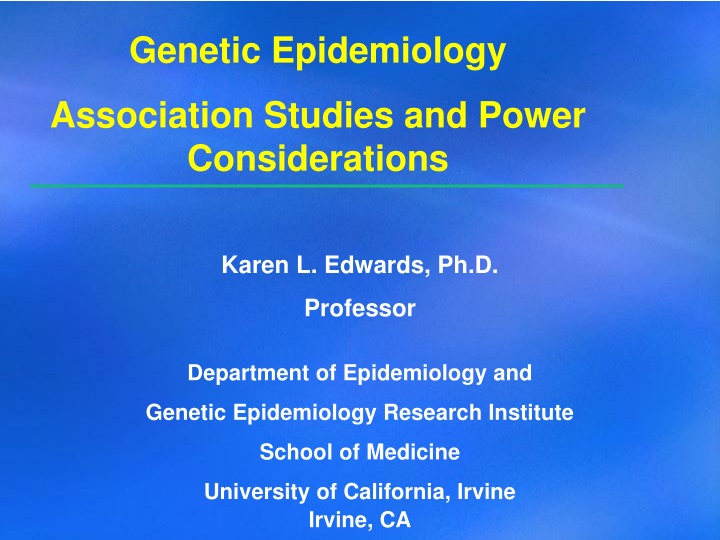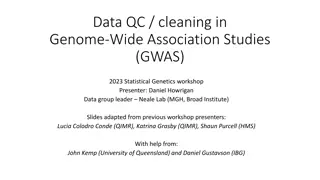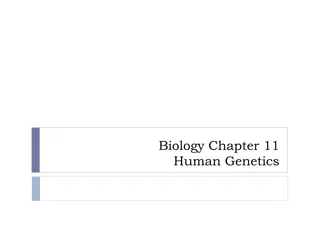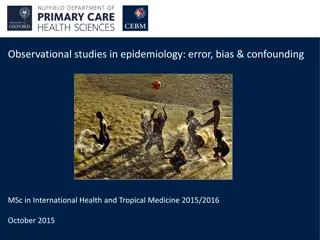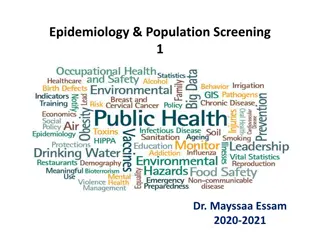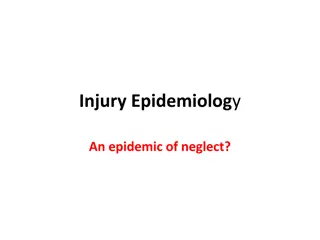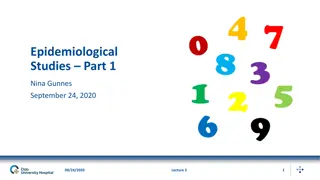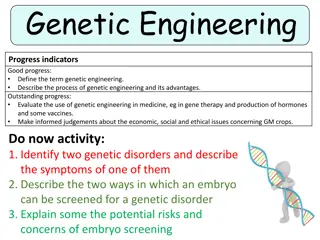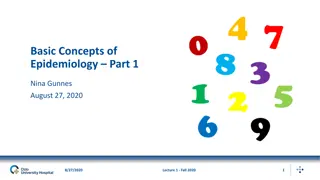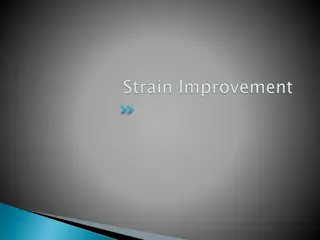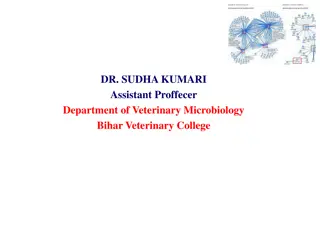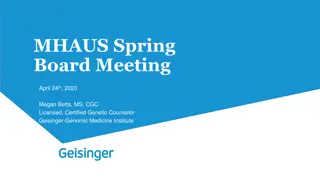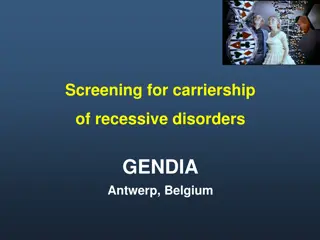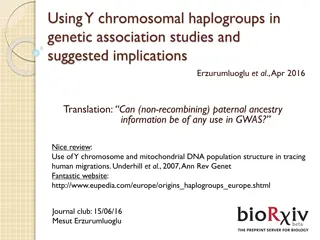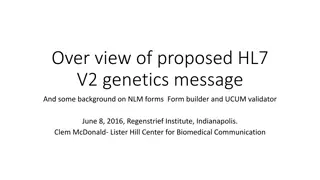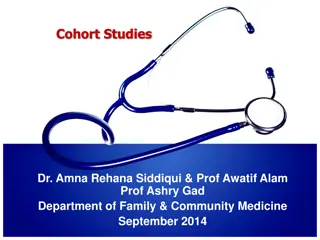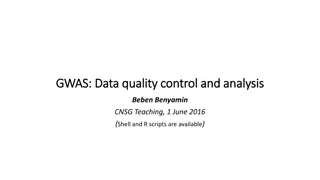Genetic Epidemiology and Association Studies Overview
This content explores genetic epidemiology, association studies, and power considerations led by Dr. Karen L. Edwards. It covers various genetic epidemiologic study approaches, including family studies, twin studies, segregation studies, linkage analysis, and linkage disequilibrium. The importance of traditional epidemiologic study design in evaluating associations between exposures and outcomes is also reviewed. Detailed explanations of concepts such as commingling, familial aggregation, major gene identification, and more are provided in this informative material.
Download Presentation

Please find below an Image/Link to download the presentation.
The content on the website is provided AS IS for your information and personal use only. It may not be sold, licensed, or shared on other websites without obtaining consent from the author.If you encounter any issues during the download, it is possible that the publisher has removed the file from their server.
You are allowed to download the files provided on this website for personal or commercial use, subject to the condition that they are used lawfully. All files are the property of their respective owners.
The content on the website is provided AS IS for your information and personal use only. It may not be sold, licensed, or shared on other websites without obtaining consent from the author.
E N D
Presentation Transcript
Genetic Epidemiology Association Studies and Power Considerations Karen L. Edwards, Ph.D. Professor Department of Epidemiology and Genetic Epidemiology Research Institute School of Medicine University of California, Irvine Irvine, CA
Overview of Genetic Epidemiologic Studies Question Approach Is there evidence for genetic influences on a quantitative trait? Commingling Is there familial aggregation? higher risk in relatives of higher correlation in relatives Family Study Is the familial aggregation caused by genetic factors? MZ twins concordance rate or correlation higher than DZ twins Twin Study Is there a major gene? Is it dominant or recessive ? (likelihoods of Mendelian models higher than environmental or polygenic model) Segregation Study Where is this major gene in the human genome? Linkage Analysis Is there linkage with DNA markers under a specific genetic model? A. Parametric Approach Is there an increased allele sharing for affected relatives (sib pairs) or for relatives with similar phenotype B. Allele Sharing Approach (sib-pair analyses) Association Study (population and family) Where is the (exact) location of this gene and which polymorphism is associated with disease?
Linkage, Review Cosegregation of two loci in related individuals 2 loci are linked if they are transmitted together from parent to offspring more often than expected under law of independent assortment During meiosis, recombination occurs with a probability of less than 50% ( <0.5) Linkage extends over larger regions of the genome than LD Good for localization Not as good at fine mapping Marker and disease loci do not need to be in the same gene we estimate how close they are with theta ( ) One of the most important tools in genetic epi
Linkage Disequilibrium Linkage Disequilibrium (allelic association) 2 loci (alleles) are in LD if across the population they are together on the same haplotype more often than expected by chance Depends on (recombination fraction and number of generations) Diminished by a factor of 1- per generation Foundation on which genetic association studies are based Complimentary to linkage studies
Epidemiologic Study Design: Review Traditional epi studies evaluate the relationship between an exposure and an outcome or disease in a population Use a range of statistical methods and approaches to evaluate evidence for the association Odds ratio Relative risk
Epidemiologic Study Design: Review Assess a relationship Exposure Disease Case-control studies Cases are individuals with new disease (incident) Controls are individuals drawn from the same population without disease (population at risk) Selection of cases and controls is very important Need to account for factors that might obscure this relationship Adjust or match for these factors Measure of association in case-control studies is the odds ratio
Epidemiology to Genetic Epidemiology A. ? Exposure Exposure Disease Disease / Outcome Confounder Some unique challenges in genetic epi studies B. Genotype Disease ? Ancestry Figure 5-1. Relationship between (A) confounding and (B) population stratification. Directed acyclical graphs (DAGs) demonstrating how a confounding factor is associated with both exposure and disease outcome (A), and, similarly, genetic ancestry can be associated with both genotype and disease outcome (B).
Study Design to Investigate Heritability of Common Diseases Family-based Linkage Analysis Association Studies Candidate/Pathway Gene Association Studies Genome-wide Association Studies Penetrance of genetic risk factor
Genetic Association Studies: Context The search for disease susceptibility genes is conducted using two main methods: The linkage approach in which evidence is sought for co-segregation between a LOCUS and a putative disease locus, using family data linkage analysis is a powerful tool for detecting the presence of a disease locus in a chromosomal region Not efficient at discriminating between small differences in recombination frequency requires data on a large number of informative gametes Genetic Association studies
Genetic Association Studies Candidate gene and genome-wide association studies Often case-control study design Basic idea: Test whether genetic polymorphisms (alleles) are associated with disease status
Association approach Evidence is sought for an association between a particular ALLELE and disease in a population There should be some evidence that the trait is under genetic control before conducting an association study Often used as a followup to linkage to narrow a region of interest (fine mapping), or to evaluate a specific candidate gene(s)
Why Do Association Studies in Unrelated Individuals? May be more powerful for detecting loci with smaller effects Fine mapping Does not require family data Faster Cheaper
Genetic Association Studies Despite the popularity, there are many challenges in conducting genetic association studies Interpretation is not always clear Replication has proven difficult Power Gene x environment interactions Gene x gene interactions Confounding Multiple testing
Possible explanations for observing an association The marker is part of the pathologic process and is the cause of the disease In this case, the same positive association would be expected to occur in all populations Linkage disequilibrium (LD) between the marker and the susceptibility gene Usually what we are detecting Generally interpreted to mean linkage
Possible explanations for observing an association, cont Confounding Genetic ancestry is the most important confounder to consider Population stratification other genetic and environmental factors such as religion, geographic location Chance Multiple testing problems with large numbers of markers
Population Structure and Population Stratification A. ? Population structure: heterogeneity in genetic ancestry Population stratification: systematic difference in population structure between cases and controls One form of population stratification is confounding by genetic ancestry Exposure Disease Confounder B. Genotype Disease ? Ancestry Figure 5-1. Relationship between (A) confounding and (B) population stratification. Directed acyclical graphs (DAGs) demonstrating how a confounding factor is associated with both exposure and disease outcome (A), and, similarly, genetic ancestry can be associated with both genotype and disease outcome (B).
Allele frequencies vary across populations Humans on the move. Worldwide genetic variation at a neutral marker. Allele frequencies of one randomly chosen microsatellite marker reveal common alleles shared in all populations and the gradual and arbitrary differences in allele frequencies across geographic regions. Populations shown in this example are Yoruba and Bantu (Africa); French, Russians, Palestinians, and Pakistani Brahui (Eurasia); Han Chinese, Japanese, and Yakut (East Asia); New Guineans (Oceania); and Maya and Karitianans (America). From King and Motulsky (2002), Science, 298: 2342-2344.
Population Stratification Example from Knowler et al., Gm Haplotype Pima ancestry %Gm Haplotvpe %NIDDM Total (crude) 6.0 Present 8% Absent 29%
Population Stratification Example from Knowler et al., Gm Haplotype Pima ancestry %Gm Haplotvpe %NIDDM Total (crude) 6.0 Present 8% Absent 29% None 65.6 Present 17.8% Absent 19.9% 50% 42.2 Present 28.3% Absent 28.8% 100% 1.6 Present 35.9% Absent 39.3%
Methods for dealing with population stratification Restrict to homogeneous population Family based study designs/analysis Adjust associations for substructure and admixture Using self-reported information on race/ethnicity Using unlinked genetic markers Genomic control Structured association Principal Component Analysis
Population Stratification: Bottom Line Population stratification is often cited as a major limitation of genetic association studies Does not strike fatal blow for association studies The impact of this form of confounding may have been exaggerated Methods exist for controlling for stratification Should not be ignored Most associations will be small- may be impacted by relatively small amount of confounding Case-control studies should address this issue in their methods and/or discussion.
How do we know if we have confounding in our sample? One approach is to evaluate if the marker alleles are in Hardy-Weinberg equilibrium (HWE) HW genotype frequencies p2 +2pq + q2 Depend on allele frequencies Evaluate HWE in the control group expect the marker to deviate from HWE among the case group if there is an association between marker and disease, particularly for a rare dominant disease susceptibility allele
Possible explanations for a significant deviation from HWE Misclassification of alleles/genotype Non-random mating in the population one form of non-random mating is population stratification assortative mating consanguineous mating Differential survival, natural selection Migration, mutation, genetic drift Sampling
Basic study design using cohort or case-control approach Cohort Case-Control Relative Risk (RR) 1 I1/Io Disease risk risk Frequency in cases Frequency in controls Genotype OR NN NS Io I1 A1 B1 B2 1 A2B1/ A1B2 A3B1/ A1B3 A2 SS I2 I2/Io B3 A3 N = normal allele, S = susceptibility allele
Alleles vs. Genotypes? Can consider the genotype or a particular allele as the exposure of interest Assumes independence (HWE) if using alleles Departures from HWE can affect the Type 1 error rate (false positive), resulting in either an inflated or deflated Type 1 error (Schaid and Jacobsen, AJE 1999;149:706- 11). Can correct for deviations from HWE to reduce chance of a false positive association
Interpretation of the OR in Gen Epi Studies Odds ratio is used to describe the relationship and strength of the association in epidemiologic studies Interpretation of the OR in gen epi studies is similar: Odds of disease in those with a particular genotype or genetic variant vs. the odds of disease in those with the reference genotype Range is the same: 0 to infinity However, risks are generally small in genetic epi studies: OR 1.2 2.0 are common That is, for an OR=1.2 a particular genotype is associated with a 20% increase odds of disease compared to those with the reference genotype
Summary: Points to Consider Maintenance of LD depends on population history and is affected by the recombination fraction ( ), such that the magnitude of allelic association (disequilibrium) decays at a rate of 1- / generation in a large, stable randomly mating population It is generally accepted that, for most human populations and most regions of the genome, substantial linkage disequilibrium is only likely to occur between loci with a recombination fraction of less than 1%. Thus, LD mapping is most useful for fine mapping over small distances or for recent mutations.
Summary: Points to Consider Different alleles maybe associated with disease in different populations random markers can be used, but more meaningful results are often obtained with candidate genes and/or functional mutations Adjustment for multiple comparisons is not straightforward Bonferroni correction is considered conservative because markers are not independent, and are often highly correlated False Discovery Rate Staged study designs
Family Based Tests of Association
Family Based Tests of Association Family based tests of association are robust to the effects of population stratification Associations identified using case-control approaches should be followed-up by a family based test One of the first family based tests to be widely used was the Transmission Disequilibrium Test (TDT) Many extensions of the TDT have been developed Qualitative traits Quantitative traits
Transmission disequilibrium test (TDT) Developed by Spielman et al (1993) Not affected by population stratification Not affected by departures from HWE Uses family data to avoid finding associations due strictly to population stratification Provides a test of Linkage AND association for a sample of trios
Transmission disequilibrium test (TDT) The basic idea behind the classic TDT (and any of its derivatives) is to: look for preferential transmission of a parental marker allele to an affected offspring use non-transmitted alleles from heterozygous parents as "controls Requires data on trios Trios consist of two parents and an affected offspring Phenotype or disease status of parents is not relevant
Formalities of the TDT The data consists of: Genotype information for parents and offspring Phenotype/Disease information for the affected child for the classic TDT The hypotheses for data consisting of trios with exactly one affected child are as follows: Ho: no linkage or no association Ha: linkage AND association For data containing trios with more than 1 affected child, the hypotheses are: Ho: no linkage Ha: linkage However, the test will only be powerful in the presence of association
TDT: Data Required and General Concept Genotype Genotype Bb Aa Ab Genotype and Phenotype
Extensions of the TDT Extended to many scenarios, including: multiallelic markers simultaneous use of several markers quantitative traits X chromosome markers pedigrees C-TDT parent of origin effects GxE
Summary: Issues to consider Having parental genotype information generally provides more power than using sibship information Only families with heterozygous parents are informative Single SNPs may not be as informative, but will depend on allele frequencies Larger sibships provide more information than smaller sibships Since association is expected over short distances (<2cM), then it makes sense to either: use a dense set of markers in a specific region of interest OR test markers that have alleles corresponding to functional mutations must also consider the issue of multiple testing
Power and Sample Size Considerations: The Basics
Power and Sample Size Critical part of study design Can either estimate power or sample size Computed by specifying model parameters Can be estimated for Mendelian disorders Generally unknown for complex diseases Deal with uncertainity by considering a range of the parameter values Can report worst-case scenario Show power over the range of values indicating median power and/or sample size Number of software programs
Power and Type 1 Error For any question you have 2 hypotheses: Ho: There is no association between disease x and marker y Ha: There is an association between disease x and marker y Power is related to Type 1 Error Both give probabilities of positive results, but under 2 different settings (Ho and Ha)
Power and Type 1 Error Power is the probability that your study will show the association given the alternative hypothesis is true That is, when Ha is true: There is an association between disease x and marker y Type 1 error is the probability that your study will show the association when the null hypothesis is true That is when Ho is true: There is no association between disease x and genotype y)
Degree of LD (r2) and power r2 impacts power, such that N2=N1/r2 Where N1 is the sample size required, and N2 is the new sample size required For example When r2=1.0, N1= N2=1,000 In contrast, when r2=0.2, N2 = 1,000/0.2 = 5,000
Assumptions for Power Calculations Power depends on Linkage disequilibrium (in association studies) Relatedness of individuals (for some designs) Pedigree or family structure Effect size Measurement error (genotype and phenotype) Penetrance Frequency of the high risk allele Genetic model (dominant, recessive,,codominant) Prevalence of disease Type of test (allelic, genotypic or trend test) Number of independent tests performed Alpha or type 1 error level
Multiple testing Issue of type 1 error (false positive) Methods to deal with multiple testing Bonferroni correction (overly conservative with large numbers of markers) False Discovery rates (FDR) Staged study designs
Software Tools Genetic Power Calculator ( many others, including Quanto) Case-control, TDT and VC linkage Purcell S, Cherny SS, Sham PC. (2003) Genetic Power Calculator: design of linkage and association genetic mapping studies of complex traits. Bioinformatics, 19(1):149-150 FBAT and PBAT Family based association testing Laird N, Horvath S, Xu X. Implementing a unified approach to family based tests of association. Genetic Epidemiol 2000:S36-42. Pawe 3D Visualize power for genetic association studies Gordon D, Haynes C, Blumenfeld J, Finch SJ (2005) PAWE-3D: visualizing Power for Association With Error in case/control genetic studies of complex traits. Bioinformatics 21:3935-3937. CaTS Genetic association studies, GWAS and candidate gene Skol AD, Scott LJ, Abecasis GR, Boehnke M. Nat Genetic 2006;38:209-13
Heat Map showing impact of allele frequency and effect size on Power of a genetic association study POWER FOR HISP 1.0 0.8 0.8 0.6 0.6 POWER 0.4 0.2 0.4 0.8 0.6 2.0 0.2 1.8 0.4 RISK ALLELE FREQUENCY 1.6 1.4 0.2 INCREASE IN RISK PER ALLELE 1.2 0.0
Example: The locus for red cell phosphatase has three alleles, A, B and C. Based on a random sample of 178 individuals, the frequencies of the genotypes were as follows: Observed AA 17 AB 86 AC 5 BB 61 BC 9 CC 0 Total 178 Are these data consistent with HWE? f(A) f(B) f(C)
